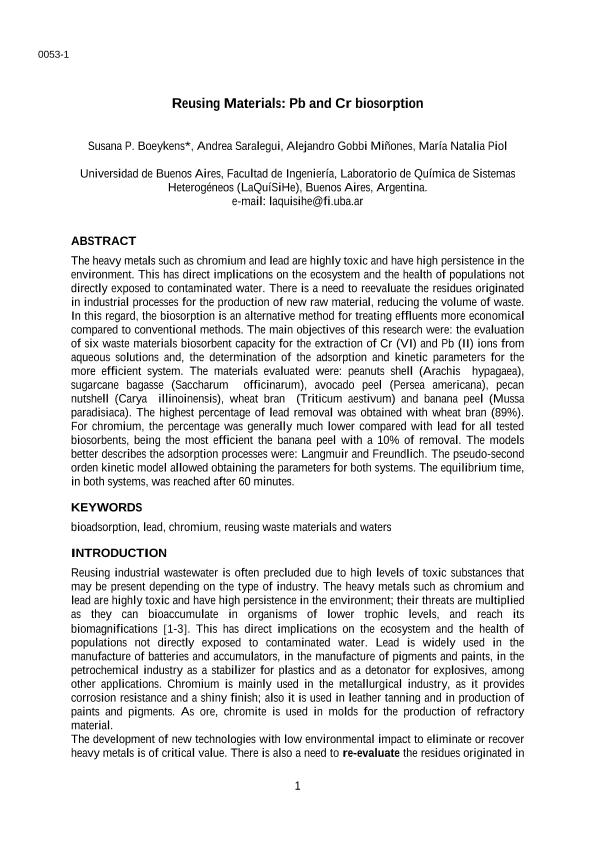Mostrar el registro sencillo del ítem
dc.contributor.author
Boeykens, Susana Patricia

dc.contributor.author
Saralegui, Andrea Beatriz

dc.contributor.author
Gobbi Miñones, Alejandro Ricardo

dc.contributor.author
Piol, María Natalia

dc.date.available
2020-06-10T13:40:53Z
dc.date.issued
2016-09
dc.identifier.citation
Boeykens, Susana Patricia; Saralegui, Andrea Beatriz; Gobbi Miñones, Alejandro Ricardo; Piol, María Natalia; Reusing Materials: Pb and Cr biosorption; University of Zagreb; CD Proceedings; 9-2016; 1-6
dc.identifier.issn
1847-7178
dc.identifier.uri
http://hdl.handle.net/11336/107134
dc.description.abstract
The heavy metals such as chromium and lead are highly toxic and have high persistence in the environment. This has direct implications on the ecosystem and the health of populations not directly exposed to contaminated water. There is a need to reevaluate the residues originated in industrial processes for the production of new raw material, reducing the volume of waste. In this regard, the biosorption is an alternative method for treating effluents more economical compared to conventional methods. The main objectives of this research were: the evaluation of six waste materials biosorbent capacity for the extraction of Cr (VI) and Pb (II) ions from aqueous solutions and, the determination of the adsorption and kinetic parameters for the more efficient system. The materials evaluated were: peanuts shell (Arachis hypagaea), sugarcane bagasse (Saccharum officinarum), avocado peel (Persea americana), pecan nutshell (Carya illinoinensis), wheat bran (Triticum aestivum) and banana peel (Mussa paradisiaca). The highest percentage of lead removal was obtained with wheat bran (89%). For chromium, the percentage was generally much lower compared with lead for all tested biosorbents, being the most efficient the banana peel with a 10% of removal. The models better describes the adsorption processes were: Langmuir and Freundlich. The pseudo-second orden kinetic model allowed obtaining the parameters for both systems. The equilibrium time, in both systems, was reached after 60 minutes.
dc.format
application/pdf
dc.language.iso
eng
dc.publisher
University of Zagreb

dc.rights
info:eu-repo/semantics/openAccess
dc.rights.uri
https://creativecommons.org/licenses/by-nc-sa/2.5/ar/
dc.subject
REUSING
dc.subject
HEAVY METALS
dc.subject
LOW COST
dc.subject
ADSORPTION
dc.subject.classification
Otras Ingeniería del Medio Ambiente

dc.subject.classification
Ingeniería del Medio Ambiente

dc.subject.classification
INGENIERÍAS Y TECNOLOGÍAS

dc.title
Reusing Materials: Pb and Cr biosorption
dc.type
info:eu-repo/semantics/article
dc.type
info:ar-repo/semantics/artículo
dc.type
info:eu-repo/semantics/publishedVersion
dc.date.updated
2020-06-08T13:48:05Z
dc.journal.pagination
1-6
dc.journal.pais
Croacia

dc.journal.ciudad
Zagreb
dc.description.fil
Fil: Boeykens, Susana Patricia. Universidad de Buenos Aires. Facultad de Ingeniería. Departamento de Química; Argentina
dc.description.fil
Fil: Saralegui, Andrea Beatriz. Universidad de Buenos Aires. Facultad de Ingeniería. Departamento de Química; Argentina
dc.description.fil
Fil: Gobbi Miñones, Alejandro Ricardo. Universidad de Buenos Aires. Facultad de Ingeniería. Departamento de Química; Argentina
dc.description.fil
Fil: Piol, María Natalia. Consejo Nacional de Investigaciones Científicas y Técnicas; Argentina. Universidad de Buenos Aires. Facultad de Ingeniería. Departamento de Química; Argentina
dc.journal.title
CD Proceedings
Archivos asociados
